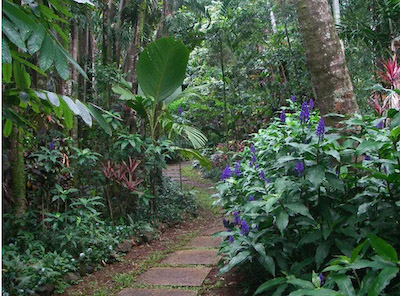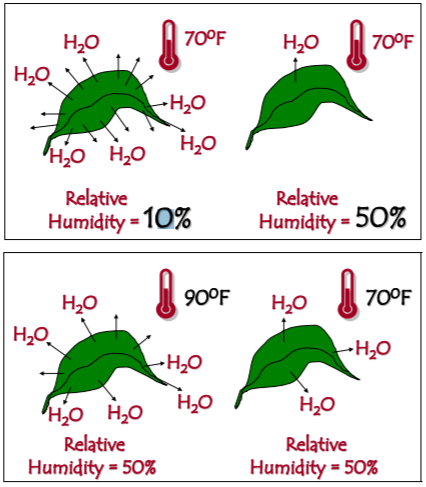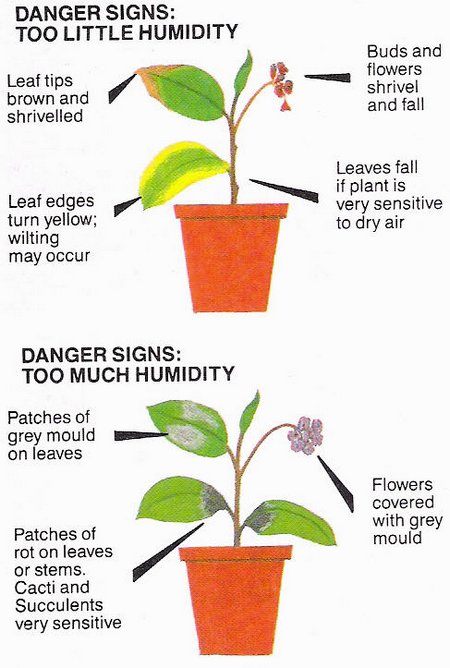Some Plants Like it Humid; Others Like it Dry
By Ann M. Mason, Fairfax Master Gardener
 Humidity! Often forgotten as one of the top four conditions for growing plants, both outdoors and indoors. Most gardeners consider light, water and soil. While those are important to grow happy, stress-free plants, humidity is vitally important, too.
Humidity! Often forgotten as one of the top four conditions for growing plants, both outdoors and indoors. Most gardeners consider light, water and soil. While those are important to grow happy, stress-free plants, humidity is vitally important, too.
Let’s define our terms. Relative humidity is the amount of water (percent) contained in the air relative to temperature. But let’s be clearer. Humidity (absolute) is a measure of water vapor in the air and is measured in grams per cubic meter (g/m3). In our hot, muggy summer southern climate, when we go outside and it ‘feels’ wet, we are reacting to absolute humidity. Relative humidity is expressed as a percentage and represents the ratio of the amount of water vapor in the air compared to the maximum amount of moisture (saturation) it can contain at a given temperature. Warmer air holds more moisture than cool air.
Governmental scientists tell us that, in our homes, humidity between 30 and 50 to 60 percent is best. Relative humidity levels above 50 percent invite unwanted mold and mildew, which can cause health issues. While levels below 20 percent restrict cockroaches and some other pests, low humidity challenges our health by drying out sensitive tissues in eyes, nose, throat and skin resulting in irritation. For both our health and our plants, scientists suggest keeping indoor relative humidity in the mid-range between approximately 30 to 50 percent.
Why is humidity important to plants? Consider you live in Arizona, a climate known for low humidity. You are advised to keep hydrated because moisture will evaporate from your body fast — so fast you might not recognize it — to cause dehydration. The same conditions apply to plants. Plants rely on a supply of water carried from the soil through roots, up stems (in the xylem) to thirsty plant cells. Healthy plants that have a sufficient supply of water stored in cells keep their shape from the turgor pressure applied by water against the cell wall. Loss of turgor pressure causes flowers and leaves to wilt and changes the shape of stomata impacting gas exchange and photosynthesis.

Humidity, temperature, and water loss from leaves
How do plants signal incorrect humidity levels? Plants without sufficient water in their cells signal the lack of turgor pressure. Look for brown or shriveled leaf tips. The edges of leaves will turn yellow and may wilt. Buds and flowers may shrivel and fall. Plants with too much humidity often attract plant diseases including fungi and molds.

Humidity effects on plants
Outdoor plants also suffer from incorrect humidity. The same principles discussed above apply. Gardeners can nurture plants by watering during the morning or evening rather than during the middle, hottest, time of the day. Water deeply to allow water to reach deep roots. Avoid frequent shallow watering because that fosters shallow roots and makes plants more prone to stresses associated with temperature and humidity. Stressed plants attract pests and diseases.
Some plants like it dry; others like it humid. Most plants prefer relative humidity between 30 and 50 percent. But if you cannot keep that range of relative humidity in your home or garden, you might try plants that better meet the relative humidity you have.
Low humidity plants that prefer humidity below 20 percent include Maidenhair Fern (Adiantum raddianum); Caladium (Caladium spp.); Croton (Codiaeum variegatum); Rabbit’s Foot Fern (Davallia fejeensis); Fuchsia (Fuchsia hybrida); and azalea (Rhododendron hybrids).
High humidity plants that prefer humidity above 50 percent include variegated Century Plant (Agave americana ‘marginata’). Aloes (Aloe aborescens, A. barbadensis, A. brevifolia); Cast Iron Plant (Aspidistra elatior); Ponytail palm (Beaucarnea recurvata); Zebra Haworthia and related plants (Haworthia fasciata, H. cuspidata, H. subfasciata; H. truncate); and Spineless Yucca (Yucca elephantipes).
Resources
Growing Indoor Plants with Success, University of Georgia Extension, Bulletin 1318
Humidity, North Carolina State University, State Climate Office